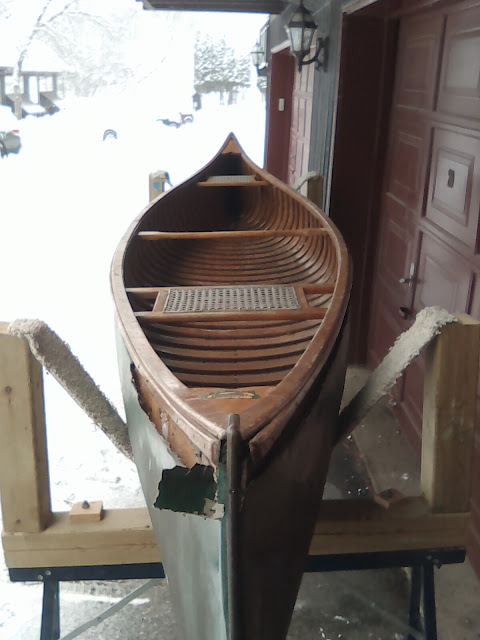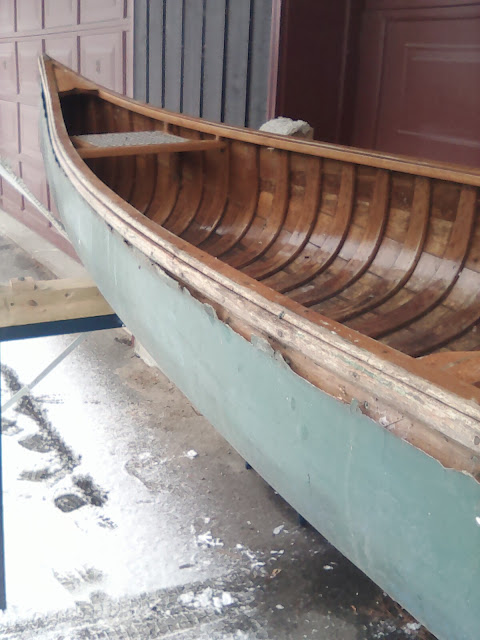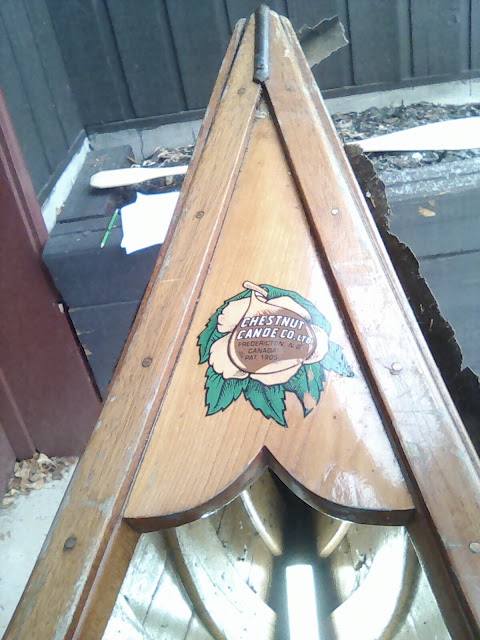Recently was able to acquire yet another cedar canvas canoe. This one might be indeed quite special.
The canoe belonged to a long time member of our cottage lake association and wanted it to go to another member willing to take on the restoration. It was picked up on a very snowy December evening where it was being stored outdoors under a tarp. At the time, daytime light had faded so it was impossible to examine the details until the next morning while a winter storm raged on.
Originally I was told it was a 16 foot Chestnut, but after proper measuring it is in fact 15 footer. 16 also typically had two thwarts rather than the single thwart found in this model. The more remarkable thing is that the canoe is constructed with "closed gunnel" system involving a much thinner outwale attached by copper nails in addition to a rail cap giving the rails a more finished look. This type of construction method is found on early dated cedar canvas canoes and was later discontinued by most companies in favour of the "open gunnel" construction, a faster and easier method of canoe building.
Researching early Chestnut catalogues reveal the closed gunnel method was built on all their 1st Grade Pleasure class canoes up until 1922. After 1925, this method of build was offered at no extra charge but the canoes in the catalogue were cited as being built with the open method. After 1928, no mention of closed rail construction appears in their company literature.
Furthermore, this 15 footer had one of the most narrow widths I've seen on for such a hull length. Most other 15 foot Pleasure class Chestnuts I've come across were had varying widths of 32-34 inches, getting wider as in the later years as the building forms changed. This one has dimensions of 15' x 31" x 11-1/2" deep.
Many folks are aware that the Chestnut factory burned in December of 1921 resulting in a complete loss of the original forms and patterns. As a result, hull shapes and dimensions significantly changed (and new models were created). Though it is yet to be confirmed by additional inspection, there is a chance that this canoe is a "pre-fire" Twozer model, making it relatively rare survivor.
However, it is quite obvious that the canoe had undergone a restoration at some point. The canvas has started to tear at the gunnel line to reveal some of the planking underneath. This planking is secured with brass tacks as opposed to the copper fasteners that would've been used during the era.
The decks are requisite heart-shape consistent with pre-fire Pleasure class canoes, but not heavily crowned or undercut and is a likely replacement. Certainly the Chestnut decal is a replacement as it looks too fresh.
The ends of the canoe are covered in a 3/8 wide brass stem band but it is secured with square head Robertson screws, rather than slot screws consistent with the time period. The single centre thwart is made from Birdseye maple but now has some serious cracks where it is attached to the gunnels. It is finely carved with rounded edges.
Overall the woodwork is in great shape. None of the ribs are cracked and just a few token pieces of planking appear damaged from the interior. Of course fully stripping the varnish and removing the canvas might reveal more. A more thorough review will have to wait until the spring, but for now the canoe is protected in a heated garage.








Sweet
ReplyDeleteSweet as honey. With more stories than we'll ever know.
ReplyDelete